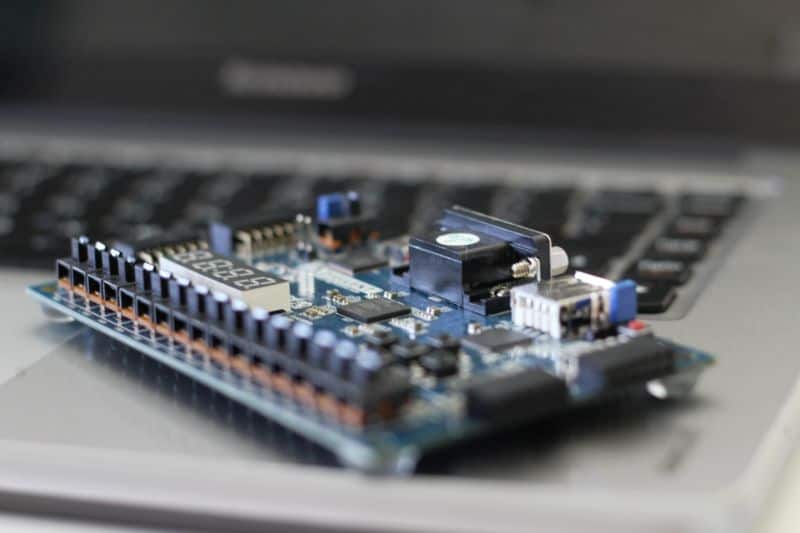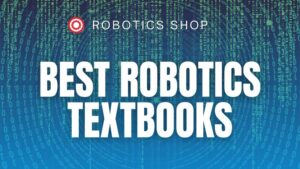FPGAs are great for all sorts of different projects. But, which FPGA should you start with if you’re a beginner? On this page, we’ll take a look at the best FPGA for beginners and explore some of the different features of each board. So, if you’re just starting out in the world of FPGAs, keep reading to learn more.
Best FPGA for Beginners
Best FPGA for Beginners
Digilent Basys 3 Artix-7 FPGA Trainer Board: Recommended for Introductory Users
Digilent Basys 3 (Buy Online) is the perfect board for beginners interested in learning FPGA design. This starter kit includes a Xilinx Artix-7 FPGA and everything you’ll need to get started on your own projects, and it’s also easy to use with many tutorials available online.
With 33,280 logic cells in 5200 slices (each slice contains 8 flip-flops and four 6-input LUTs), and the XC7A35T-1CPG236C has 90 DSP slices with an internal clock speed of 450MHz+ which makes it ideal for signal processing applications. Furthermore, this board features 16 user switches and 16 user LEDs, 5 user pushbuttons, a 4 digit 7 segment display, and three Pmod ports which enable you to easily interface sensors and other external input devices.
Arty A7: Artix-7 FPGA Development Board for Makers and Hobbyists (Arty A7-100T)
The Arty A7 (Buy Online) is a high-performance FPGA development board that features a Xilinx XC7A100TCSG324-1. FPGA. It’s the perfect platform for learning about digital logic design and building embedded systems from scratch. And with its onboard XADC, USB programming circuitry, Ethernet port, Arduino/chipKIT shield connector, and 4 Pmod connectors, it has everything you need to get started with your first project today.
The Arty A7 is the best FPGA for beginners, and it has an internal clock speed of 450MHz+, an on-chip analog to digital converter (XADC), and it is programmable over a standard JTAG port
The Arty A7-100T also comes with 256MB of DDR3L memory, and 16MB Quad SPI Flash. Best of all it can be powered via USB or any 7V-15V source, and it even has a built-in 10/100 Mbps Ethernet and USB UART Bridge.
Plus, it has a wide range of interactive input/output devices including 4 Switches, 4 Buttons, 1 Reset Button, 4 LEDs, and 4 RGB LEDs.
Digilent Zybo Z7: Zynq-7000 ARM/FPGA SoC Development Board (Zybo Z7-20)
The Digilent Zybo Z7 (Buy Online) is a good FPGA for beginners because it has the same programmable logic equivalent to Artix-7, but with more memory. It also features an ARM processor that allows you to develop software in C/C++ while getting access to all of the peripherals on board.
The Zynq-7000 architecture combines an ARM Cortex A9 processor with Xilinx’s hardwired logic (FPGA) on a single board. This combination enables the Zybo Z7 to provide designers with the best of both worlds by leveraging the flexibility of FPGA programming along with the ease of embedded control using an ARM processor.
With its easy access to I/O peripherals such as HDMI, video input & output, MIPI CSI-2 camera connector, and high DDR3L memory support; the Zybo Z7 is ideal for multimedia applications including robotics vision systems or even home entertainment systems such as digital signage displays or media players – all without needing any external add-on cards.
Overall, the Zybo Z7 provides a complete hardware and software solution for developing systems that combine processors and programmable logic in one board. It’s designed to be flexible, so you can use it as an embedded computer or as a standalone controller board. And all of the I/O needed for interfacing peripherals like sensors, displays, motors, GPS modules, etc., are provided on expansion connectors making it simple to connect external devices without having to solder or buy expansion boards.
Digilent Nexys A7-100T: FPGA Trainer Board Recommended for ECE Curriculum
The Digilent Nexys A7-100T (Buy Online) is a powerful development board based on the Xilinx Artix-7 family of FPGAs. It’s designed specifically for students and hobbyists who want to learn how to use an FPGA without spending hundreds or thousands on tools or hardware.
With the Nexys A7, you get a powerful development board with tons of features at an unbeatable price point. This makes it easy for anyone interested in learning about digital circuits, programming embedded systems, or prototyping new products to get started right away.
It includes an on-chip analog-to-digital converter, USB JTAG programming circuitry, microSD card connector system connectivity (10/100 Mbps Ethernet). And it has interaction and sensory devices (3 axis accelerometer, PDM microphone, PWM audio output) as well as 2 four digit seven segment displays. And the internal clock speed of 450 MHz+ makes it ideal for rapid prototyping or training with programs such as LabVIEW or Verilog HDL.
Taidacent FPGA Development Board with Spartan6 XC6SLX Compatible with Arduino
The Taidacent FPGA Development Board (Buy Online) is a complete development platform that combines the power and flexibility of a Spartan6 LX9 FPGA with the ease of use of an Arduino compatible microcontroller (ATmega32U4). It features 8 analog inputs, 8 general-purpose LEDs, 1 LED used to show when the FPGA is working and a USB addressable microcontroller that makes it easy to program the FPGA.
ALINX AX7A035: Artix-7 XC7A35T (FPGA Development Board + USB Downloader)
The ALINX Brand XILINX A7 Artix-7 XC7A35T FPGA Development Board (Buy Online) is the easiest way for beginners to get started with a powerful FPGA board. It provides a low-cost entry point into high-speed digital circuits design and prototyping while eliminating the steep learning curve associated with other high-performance development kits.
Artix-7 XC7A35T Features:
- PCIe X2 Gen2 Connector
- 2 HDMI Connectors (Input/Output)
- 10/100/1000 Mbps Ethernet
- 40-Pin Connectors
- JTAG Connector
- USB-to-Uart
OrangeCrab (25F) – Lattice ECP5 FPGA Board
OrangeCrab (Buy Online) is an open-source ECP5 FPGA board that will get you started in hardware hacking without all the headaches of using closed source tools from large corporations like Xilinx or Altera.
OrangeCrab is a different kind of FPGA board that offers a much better user experience than other boards on the market. It has an easy-to-compile opensource toolchain with no proprietary software, and it’s available at an affordable price point, so it’s perfect for anyone looking to start learning FPGA programming cheaply.
Intel/Altera MAX10 FPGA Development Board – MaxProLogic
The MAX10 Development Kit (Buy Online) has everything that a beginner needs to get started with FPGA logic programming and it doesn’t cost an arm and a leg like other boards do. This development board has everything you need right on board, so there’s no hassle with external programming hardware. All of the necessary components are included on this single-board solution including 4,000 logic elements (LEs), 8 12 bit analog input channels, and 8 green user-configurable LEDs along with an on/off controller switch and power pushbutton switch. And it includes tutorials that will help you quickly get up to speed using your own code written using Quartus Prime Lite software which is completely free to download and use.
How To Start Learning FPGA
So, you’ve decided to start learning FPGA programming. Congratulations. This is a very rewarding journey that will take you on an amazing technical adventure. But where do you start? What are the best resources to get you up to speed quickly? Below you’ll find some excellent FPGA Books for Beginners along with a few Online FPGA Video Courses.
FPGA Books for Beginners
Learning FPGAs: Digital Design for Beginners with Mojo and Lucid HDL
Learning FPGAs (Buy Online) is a book for beginners who want to start using these chips in their projects as soon as possible. It takes a practical approach by guiding readers through setting up their development environment and teaching them how to use it effectively from the beginning. And the author uses his experience designing hardware systems to help readers build real-world applications using Lucid, which is a Verilog-based hardware description language that has a syntax similar to C-based programming languages.
FPGA Programming for Beginners
FPGA Programming for Beginners (Buy Online) will help you get up and running with your first FPGA design quickly and easily so that you’ll have time left over for creating awesome projects. You’ll start off by getting an overview of what an FPGA is good at, before diving into the details of how it works under the hood. Then this book walks through setting up your hardware in order to start building a calculator followed by some higher-level topics like Parallelism, Pipelined Design, and VGA output.
Verilog by Example: A Concise Introduction for FPGA Design
Verilog by Example (Buy Online) makes it easier than ever to learn the fundamentals of this language, while also providing you with practical applications for your own projects. You’ll learn how to create efficient designs from scratch using clear, easy-to-follow examples designed for beginners but still relevant even if you’re already familiar with Verilog. And the author’s approachable style will help guide you through each example without overwhelming or confusing you along the way.
Programming FPGAs: Getting Started with Verilog
Programming FPGAs: Getting Started with Verilog (Buy Online) is written for someone who knows nothing about FPGAs or Verilog. It doesn’t assume you have any prior knowledge of programming or electronics. You’ll learn everything from the basics like how an FPGA works to setting up your development environment, to writing code in Verilog that will run on your hardware device.
The author has worked hard to make this book as beginner-friendly as possible so anyone can understand what’s going on without getting bogged down by technical jargon and unnecessary details. He has also tried his best to keep things simple while still covering most of the important topics including some intermediate-level examples such as VGA output.
Learn FPGA Programming Online – FPGA Courses
Introduction to FPGA Design for Embedded Systems
Introduction to FPGA Design for Embedded Systems (Enroll for Free) breaks down the process of learning FPGA programming into manageable chunks and teaches you how to create an example design using the Quartus Prime Development Suite. You will learn about HDLs, RTL coding, simulation, timing closure analysis, synthesis, place and route algorithms, and much more.
The Introduction to FPGA Design for Embedded Systems online training course provides everything you need to get started in this fascinating field. By following along with this courses expert instructor’s video lectures along with reading through the supplemental material provided in each chapter, completing homework assignments at your own pace, and practicing what you’ve learned by working through lab examples – we guarantee that once completed; this course will provide a solid foundation upon which you can build your future career.
Learn VHDL and FPGA Development
Learn VHDL and FPGA Development (View Course) will help you get started with VHDL programming so that you can write your own designs or modify existing ones. You’ll learn how to simulate these designs in ModelSim or ISim and then implement them on an FPGA development board.
The instructor has designed this course for both beginners and intermediates in VHDL/FPGA design who are looking for a way to get started quickly without the headaches of learning everything from scratch. By following along with this course, anyone should be able to pick up the basics of VHDL programming as well as some intermediate-level concepts within just a few days/weeks.
Learn the Fundamentals of VHDL and FPGA Development
Learn the Fundamentals of VHDL and FPGA Development (View Course) is a course designed for anyone who wants to learn more about programming an FPGA. The course goes through everything from beginner-level concepts like what an HDL language is, up through writing your own projects using state machines as well as examples showing how each project works individually so you can build up your understanding of VHDL and FPGA development.
FPGA Beginner Projects
Make: FPGAs: Turning Software into Hardware with Eight Fun and Easy DIY Projects
Make: FPGAs (Buy Online) breaks down this complex subject into eight fun and easy DIY projects that will teach you how to use an FPGA in the real world. From blinking LEDs and making music to creating your own video game console and even building a Bitcoin miner, these hands-on tutorials cover everything from setting up your first development board to writing code for your very own project.
Table of Contents
















